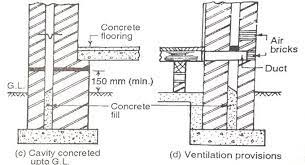In the realm of construction, the design and construction of walls are critical elements that determine a building’s structural integrity, energy efficiency, and overall performance. One notable construction technique that has gained prominence for its benefits is cavity wall construction. This article explores the concept, advantages, and applications of cavity walls, shedding light on their significance in contemporary building practices.
Defining Cavity Walls:
A cavity wall consists of two separate masonry wythes (layers) with a gap or cavity between them. These wythes can be constructed using various materials such as bricks, concrete blocks, or other masonry units. The cavity between the wythes is a key characteristic of this construction technique and serves several purposes that contribute to the overall performance of the wall.
Purpose and Functionality of the Cavity:
The cavity in a cavity wall serves multiple purposes, with one of the primary functions being moisture management. By creating a gap between the inner and outer wythes, any water that penetrates the outer layer is less likely to reach the interior of the building. This helps prevent water damage, mold growth, and other issues associated with moisture infiltration.
Thermal Insulation:
Cavity walls provide enhanced thermal insulation compared to solid walls. The air gap within the cavity acts as a natural insulator, reducing heat transfer between the interior and exterior of the building. This results in improved energy efficiency, as the building requires less heating or cooling to maintain a comfortable temperature.
Sound Insulation:
The cavity in cavity wall construction also contributes to sound insulation. The air gap helps to reduce the transmission of sound waves, providing a quieter and more comfortable indoor environment. This is particularly advantageous in buildings located in noisy urban areas or near transportation hubs.
Construction Materials:
Cavity walls can be constructed using various materials for both the inner and outer wythes. Common choices include bricks, concrete blocks, or even different combinations of materials to achieve specific performance requirements. The selection of materials depends on factors such as climate, budget, and desired aesthetics.
Construction Process:
The construction of a cavity wall involves laying the inner and outer wythes with a gap left between them. Ties, typically made of metal or other durable materials, connect the two wythes and provide stability to the structure. The cavity is often filled with insulation material to enhance thermal performance.
Ventilation and Moisture Control:
Proper ventilation within the cavity is crucial for moisture control. Weep holes, typically placed at the base of the wall, allow any accumulated water to drain out, preventing moisture from being trapped within the cavity. This ventilation mechanism is a key aspect of cavity wall design to maintain a dry and healthy interior environment.
Applications in Residential and Commercial Buildings:
Cavity wall construction is widely used in both residential and commercial buildings. Its versatility and ability to address various construction challenges make it suitable for a range of applications. From single-family homes to large office complexes, cavity walls are chosen for their performance benefits and adaptability to different architectural styles.
Environmental Considerations:
Cavity walls contribute to environmental sustainability by improving a building’s energy efficiency. Reduced reliance on heating and cooling systems helps lower energy consumption and, consequently, reduces the building’s carbon footprint. Additionally, the durability and longevity of cavity wall construction contribute to sustainable building practices.
Conclusion:
Cavity wall construction stands as a testament to the innovation within the construction industry, addressing challenges related to moisture control, thermal insulation, and sound transmission. As builders and architects continue to prioritize energy efficiency and sustainable practices, cavity walls offer a reliable solution that enhances the performance and comfort of modern buildings. Whether in residential neighborhoods or bustling urban centers, the strength within the cavity wall remains a cornerstone of contemporary construction practices.

